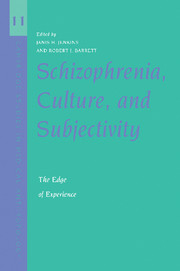Book contents
- Frontmatter
- Contents
- Contributors
- Preface
- Acknowledgments
- Schizophrenia, Culture, and Subjectivity
- Introduction
- Part 1 Culture, Self, and Experience
- 1 Schizophrenia as a Paradigm Case for Understanding Fundamental Human Processes
- 2 Interrogating the Meaning of “Culture” in the WHO International Studies of Schizophrenia
- 3 Kurt Schneider in Borneo: Do First Rank Symptoms Apply to the Iban?
- 4 Living Through a Staggering World: The Play of Signifiers in Early Psychosis in South India
- 5 In and Out of Culture: Ethnographic Means to Interpreting Schizophrenia
- Part 2 Four Approaches for Investigating the Experience of Schizophrenia
- Part 3 Subjectivity and Emotion
- Index
- References
3 - Kurt Schneider in Borneo: Do First Rank Symptoms Apply to the Iban?
Published online by Cambridge University Press: 25 January 2010
- Frontmatter
- Contents
- Contributors
- Preface
- Acknowledgments
- Schizophrenia, Culture, and Subjectivity
- Introduction
- Part 1 Culture, Self, and Experience
- 1 Schizophrenia as a Paradigm Case for Understanding Fundamental Human Processes
- 2 Interrogating the Meaning of “Culture” in the WHO International Studies of Schizophrenia
- 3 Kurt Schneider in Borneo: Do First Rank Symptoms Apply to the Iban?
- 4 Living Through a Staggering World: The Play of Signifiers in Early Psychosis in South India
- 5 In and Out of Culture: Ethnographic Means to Interpreting Schizophrenia
- Part 2 Four Approaches for Investigating the Experience of Schizophrenia
- Part 3 Subjectivity and Emotion
- Index
- References
Summary
Introduction
This chapter reports on an ethnographic and clinical inquiry into the experience of psychotic illness among the Iban, an indigenous people of Sarawak, Malaysia. Its starting point is a problem of translation, for in the course of this study, considerable difficulties arose in translating the Present State Examination (PSE), a standardized psychiatric diagnostic interview, from English into the Iban language. I critically examine these difficulties in order to raise more fundamental questions concerning the way schizophrenia is experienced, defined, and studied cross-culturally. Some of these questions are concerned with the nexus between language and social relationships and with cultural variations in the way people talk about their subjective experiences. Others are concerned with variations in the way particular subjective experiences – notably perceptions and thoughts – are themselves signified and interpreted within different cultural settings. These issues have a bearing on the so-called First Rank Symptoms (FRS), symptoms that have long been regarded as important to the diagnosis of schizophrenia. They carry implications, therefore, for the way schizophrenia itself is defined and conceptualized. I will argue that future cultural and biological research might fruitfully focus on patients who suffer from long-term auditory hallucinations, irrespective of diagnosis, rather than on patients who fall within the category of schizophrenia as it is currently defined. In sum, this chapter is a record of an encounter between a psychiatry that has its roots in European phenomenological psychopathology and Iban ways of knowing and experiencing psychotic illness.
- Type
- Chapter
- Information
- Schizophrenia, Culture, and SubjectivityThe Edge of Experience, pp. 87 - 109Publisher: Cambridge University PressPrint publication year: 2003
References
- 9
- Cited by



